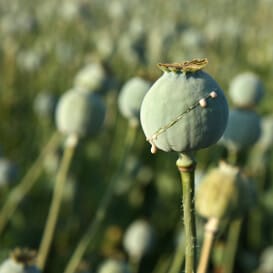

By: Lakeview Health
The Opium Poppy and its Derivatives
The opium poppy is a plant with an attractive bloom that ranges in color from red to blue and grows in various locations across the globe, although in most places it is illegal. Opium comes from the fruit, or unripened seed heads, of the poppy plant, which produces a liquid latex or resin when it is cut. When the resin dries, it is opium. A number of substances are derived from this resin, including morphine, heroin and codeine, and are called opiates. Morphine, one of the most effective painkillers, was derived from opium in 1805, followed by codeine. Heroin was created from morphine in 1874. These drugs are powerful narcotics that are used for a number of medicinal purposes such as the treatment of pain or to induce sleep. Opiates have a number of negative effects as well including the potential for abuse, loss of memory, dilation of blood vessels, confusion, sexual dysfunction and respiratory problems. In fact, heroin is so addictive that in 1924 it became illegal in the United States.
- Toxipedia: The Opium Poppy (PDF) – An article describing the poppy plant, the origins of opium and its effects upon society.
- Opioids – A web page about opium. This resource discusses the production of opium as well as the problem of opium addiction.
Early Opium Use
The history and use of opium dates as far back as 3400 B.C. in Mesopotamia. At that time, opium was referred to as the “joy plant”, or Hul Gil, by the Sumerians. The plant eventually made its way to Egypt and the Egyptians became known for their cultivated poppy fields. The opium poppies from these fields were used for trade and medicinal purposes. For example, the mashed grains of the plant were used to help stop children from crying and opium soaked sponges were used during surgeries. Hippocrates further documented the medicinal uses of opium in 460 B.C., as a narcotic and for the treatment of women, epidemics and internal diseases.
- Prospect- On Opium: Its History, Legacy and Cultural Benefits– This web page discusses the benefits and dangers of opium. Information about its medicinal uses and long history are included.
- The Pernicious Opium Poppy – An article about opium describing its appearance, history and the drugs that are derived from it.
Opium Use in Asia
Opium use is thought to have originated in the Mesopotamian region of Asia over 5,000 years ago. Its use eventually spread as far west as the Roman Empire and, in later centuries, as far east as China. Two major opium trade routes eventually appeared in Asia: the Golden Triangle, a region including Southeast Asia and the Golden Crescent, including Pakistan and Afghanistan. The Golden Triangle was the world’s largest producer of opium until it was surpassed by Afghanistan in the early 21st century. Opium use was also prevalent in the medieval-era Middle East as well as the Assyrian Empire, Babylonian Empire and Egypt. Opium was also used for narcotic and medicinal purposes in the Ottoman Empire and Persia. Today, global opium production is centered in Afghanistan. The Taliban organization has traditionally allowed opium production in the region while levying a tax on the product to fund their activities. In the late 1990s, the Taliban controlled nearly all opium production in the country, accounting for nearly three of every four pounds of opium distributed around the world. In 2000, Mohammed Omar, the leader of the Taliban, issued a decree banning the growing of poppy plants, which led to a production drop of over 90 percent. However, this didn’t lead to the destruction of the substantial existing stockpiles of opium and it drove the prices of opium upward. After the United States declared war on the Taliban in the early 2000s, many impoverished farmers resumed producing opium. As a result, Afghanistan obtained its new status as the opium exporter to the world.
- Opium History, Basic Terms – A glossary of terms that are related to opium. This page discusses terms ranging from the Asian opium zone to opium as a commodity and southwest Asia.
- The Emergence of Modern China: The Opium War, 1839-42 – This historical resource contains information about the Opium War and the way in which Western powers subjugated China in order to profit from the drug trade.
The Opium Trade
The opium trade greatly increased the presence and use of opium in China. In the early 19th century, British merchants trading with China from the port of Canton purchased 23 million pounds of tea yearly as well as items such as silk and porcelain. However, in accordance with the Qing dynasty, they were restricted in where and how they could trade with the Chinese. Because of the large sums of silver that they were paying the Chinese for tea, they wanted to trade in something that would be equally profitable for them and would balance out the uneven trading. As a result, they turned to opium from India. The importation of opium was illegal, but British traders smuggled it into the country illegally at an increasing rate. The smuggling of opium eventually led to the Chinese destroying some 20,000 chests of the drug, which caused the start of the first of the Opium Wars in 1839. The outcome of the war was Britain seizing ports and taking over Canton. Britain won the war in 1843 and was ceded Hong Kong. In addition, they opened more ports for the importation of opium. The second Opium War took place 15 years after the first. The British, receiving help from the French this time, also won, resulted in the opening of even more ports and the legalization of opium in China. The import of opium to Britain continued to rise as did the addiction that occurred as a result of it. In an effort to compete with the importation of opium, China began to grow poppy in place of grain in some locations, but this only resulted in more opium and more problems as a result of it. In 1907, efforts were made to reduce the opium trade with the Ten Years’ Agreement, which called for the cultivation of opium in China as well as the imports of Indian opium to England over a ten-year period to decrease. By 1917, opium use in China was on the decline. During the Communist reforms in China in the 1950s, Chairman Mao Zedong waged an all-out war on opium, replacing poppy fields with alternative crops, forcing addicts into therapy and administering the death penalty to drug dealers. Opium use and production in China was almost completely eradicated by the Communist Party’s actions. In Afghanistan, the opium trade has been profitable for many farmers who could not make a living on other crops. This is because a kilogram of opium can be a hundred times more profitable to a farmer in Afghanistan than producing a crop such as wheat. In addition, opium is also profitable to warlords and terrorist groups like the Taliban which make money off taxing its sales. Afghanistan is the most prolific producer and exporter of opium to the world, currently producing over 90 percent of worldwide supply. In 2011 alone, the country produced 6,400 tons of the drug.
- MIT Visualizing Cultures- The First Opium War: Opium Trade– A detailed and lengthy explanation of the opium trade. This page provides solid information on the Opium Wars and the way they affected the opium trade.
- Opium Trade and Environment– A description of the events surrounding the opium trade and the Opium Wars. This page is found on the American University, Washington D.C. website.
The Fight Against Opium Use in Recent History
The struggle to eliminate opium production and use has been a long, difficult process that has had mixed results at best. The United Nations engaged in a joint effort with Taliban leader Mohammed Omar to halt the production of opium in Afghanistan. However, their efforts only caused the price of opium to rise. When the Taliban was temporarily driven from power by American invasion after the attacks on 9/11, Afghan farmers rushed to resume poppy cultivation and opium production. Many different methods have been considered or deployed to stop opium production. The Russian Federation, for instance, once offered a plan to spray poppy fields to kill the plants, thus drastically cutting the supply of opium. This plan was later rejected by the North Atlantic Treaty Organization (NATO) on the basis that it would drive farmers into abject poverty. Numerous other interdiction efforts have been launched, resulting in the capture of tons of opium, yet the production of opium continues to rise. Afghanistan has been ground zero in the effort to stop opium production. Generally, these efforts have only served to raise the price of opium and the other illegal drugs that are derived from it. The increase in opium’s value has caused farmers to join in its production for the sake of their livelihoods. The consequences of this are evident in the fact that Afghanistan now produces historically large crops of opium and almost completely monopolizes the world’s opium market.
- Myths and Facts About Fighting the Opium Trade in Afghanistan – The State Department’s web page dispelling various myths concerning opium production in Afghanistan.





